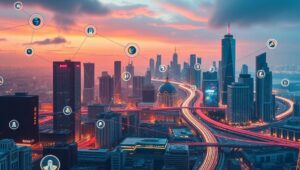The IoT-Powered Smart City of 2028: Reality Check
The vision of the smart city, powered by the Internet of Things (IoT), has been circulating for years. By 2028, how much of that vision will be reality? This post examines the advancements, challenges, and realistic expectations for IoT in urban environments.
What is a Smart City?
A smart city leverages technology, data, and connected devices to improve the quality of life for its citizens. This includes optimizing infrastructure, transportation, energy consumption, public safety, and various other services. IoT forms the backbone, connecting sensors, devices, and systems to collect and exchange data in real-time.
Key Areas of IoT Implementation in Smart Cities:
- Smart Transportation:
- Current Status: Adaptive traffic signals, real-time public transit tracking, and connected vehicle systems are becoming more prevalent.
- 2028 Outlook: Expect wider adoption of autonomous vehicles, integrated traffic management systems that optimize flow based on real-time conditions, and smart parking solutions that reduce congestion.
- Smart Energy:
- Current Status: Smart grids are being deployed to optimize energy distribution and reduce waste. Smart meters provide real-time energy consumption data.
- 2028 Outlook: Increased deployment of renewable energy sources integrated into the grid, advanced energy storage solutions, and intelligent management systems that balance supply and demand.
- Smart Waste Management:
- Current Status: Sensors in waste bins that monitor fill levels and optimize collection routes.
- 2028 Outlook: Predictive waste management systems that anticipate waste generation patterns, robotic waste sorting, and increased recycling rates.
- Public Safety:
- Current Status: Surveillance systems, gunshot detection technology, and real-time crime mapping.
- 2028 Outlook: AI-powered predictive policing, drone-based surveillance, and enhanced emergency response systems.
- Infrastructure Management:
- Current Status: Sensors embedded in bridges, roads, and buildings to monitor structural health.
- 2028 Outlook: Self-healing infrastructure that automatically detects and repairs damage, predictive maintenance systems that prevent failures, and optimized resource allocation.
Challenges and Obstacles:
While the potential of IoT in smart cities is significant, several challenges need to be addressed:
- Data Security and Privacy: The vast amount of data collected by IoT devices raises concerns about security breaches and privacy violations. Robust security measures and data governance policies are essential.
- Interoperability: Different IoT devices and systems often use different protocols and standards, making it difficult to integrate them seamlessly. Standardization is crucial for interoperability.
- Scalability: Smart city deployments can involve millions of devices, requiring scalable infrastructure and management systems.
- Cost: Implementing and maintaining IoT infrastructure can be expensive, requiring careful planning and investment.
- Digital Divide: Ensuring that all citizens have access to the benefits of smart city technologies is essential to avoid exacerbating existing inequalities.
The Reality Check:
By 2028, expect to see significant advancements in IoT-powered smart cities, particularly in areas like transportation, energy management, and public safety. However, widespread adoption will depend on addressing the challenges outlined above. The smart city of 2028 will likely be a patchwork of implementations, with some cities leading the way and others lagging behind. The key will be to focus on practical applications that provide tangible benefits to citizens while addressing the ethical and security considerations.
Conclusion:
The IoT-powered smart city of 2028 is not a futuristic fantasy, but a tangible evolution of urban environments. While challenges remain, the potential benefits are immense. By focusing on practical solutions, addressing ethical concerns, and fostering collaboration, cities can leverage IoT to create more livable, sustainable, and efficient urban environments for all.




